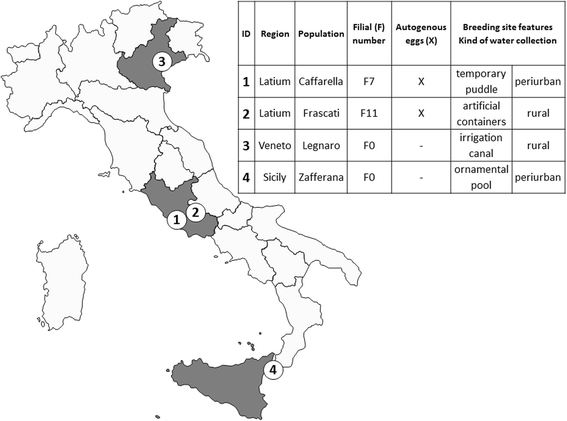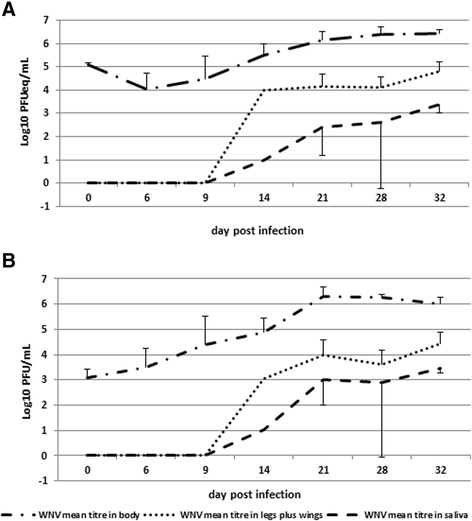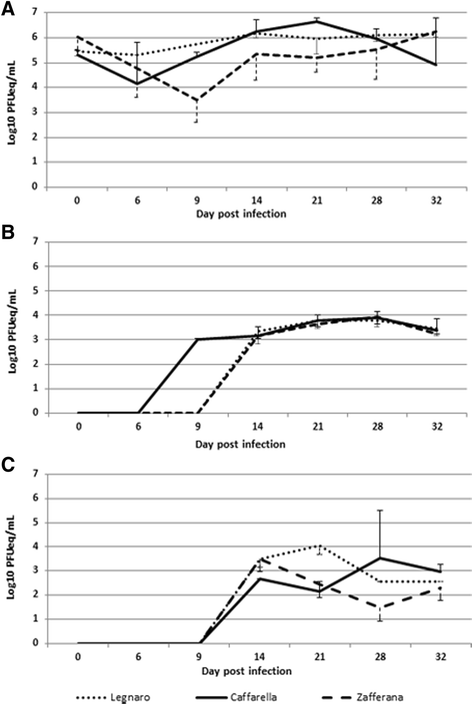Experimental studies on comparison of the vector competence of four Italian Culex pipiens populations for West Nile virus
- PMID: 26383834
- PMCID: PMC4574231
- DOI: 10.1186/s13071-015-1067-z
Experimental studies on comparison of the vector competence of four Italian Culex pipiens populations for West Nile virus
Abstract
Background: West Nile virus (WNV) is a vector-borne disease responsible for causing epidemics in many areas of the world. The virus is maintained in nature by an enzootic bird-mosquito-bird cycle and occasionally transmitted to other hosts, such as equines and humans. Culex species, in particular the ubiquitous species Culex pipiens is thought to play a major vector role both in enzootic and epizootic maintenance and transmission of WNV. Introduced in Europe in recent years, since 2008 WNV has been stably circulating mainly in the Northeastern regions of Italy, although sporadic equine and/or human cases, as well as WNV infected Cx. pipiens pools, have been recorded in other Italian areas. The scope of our study was to evaluate the potential competence of some Italian populations of Cx. pipiens to transmit WNV and to assess their ability for vertical transmission of the virus. For this purpose four Italian populations, from different areas, were experimentally infected.
Methods: After the infectious blood meal, fed females were monitored for 32 days to determine the length of viral extrinsic incubation period. WNV titre of infected mosquitoes was evaluated both by quantitative Real Time PCR and viral titration by Plaque Forming Units/ml (PFU/mL) in VERO cells. Potential Infection, Dissemination, Transmission rates (IR, DR, TR) were assessed by detection of the virus in body, legs plus wings and saliva of the fed females, respectively.
Results: All tested populations were susceptible to the WNV infection. The viral presence in legs and wings demonstrated the ability of WNV to disseminate in the mosquitoes. Viral RNA was detected in the saliva of tested populations. No significant differences in TR values were observed among the four studied populations. The offspring of the Cx. pipiens infected females were WNV negative.
Conclusions: Our study addressed an important issue in the knowledge on the complex WNV-vector relationships in Italy, indicating that all Italian Cx. pipiens populations tested exhibited vector competence for WNV. Further studies should be performed in order to better clarify the role of other factors (vector density, climatic conditions, reservoir presence etc.) in order to predict where and when WNV outbreaks could occur.
Figures



References
-
- Beck C, Jiménez-Clavero MA, Leblond A, Durand B, Nowotny N, Leparc-Goffart I, et al. Flaviviruses in Europe: complex circulation patterns and their consequences for the diagnosis and control of West Nile Disease. Int J Environ Res Public Health. 2013;10:6049–83. doi: 10.3390/ijerph10116049. - DOI - PMC - PubMed
Publication types
MeSH terms
LinkOut - more resources
Full Text Sources
Other Literature Sources

